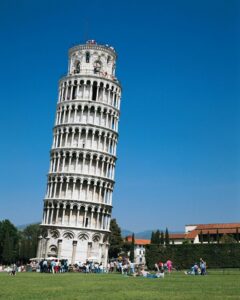The Leaning Tower of Pisa: A Tower of Wonder and Architectural Marvel
The Learning Tower of Pisa: 850th Birthday
Recently the learning tower of Pisa celebrate it 850th birthday.
it’s took almost two centuries to build.
the learning Tower of Pisa designated a World Heritage Site by UNESCO
it is one of the most renowed architectural Marvel in the world
It took 199 years to build.The learning Tower in pisa.

Architect: Bonanno Pisano
Opened: 1372

Materials: Marble, Rock
Province: Province of Pisa
Construction started: 9 August 1173
Floors: 8
Height: 57 m
The Construction of the tower is started in 1173 and come to ended in 1372
Some structural engineers feel that continued delays in construction may have given the soil underneath the already slightly learning tower time to compress ultimately saving it from toppling over.
The Leaning Tower of Pisa, often simply referred to as the Tower of Pisa, is one of the most iconic and recognizable landmarks in the world. Located in the picturesque Italian city of Pisa, this freestanding bell tower has fascinated visitors for centuries with its distinctive tilt. In this blog post, we’ll delve into the intriguing history, engineering marvels, and cultural significance of this iconic tower.
A Glimpse into History
Construction and Purpose
The construction of the Leaning Tower of Pisa began in the 12th century, in 1173. It was intended to be a freestanding bell tower for the nearby Pisa Cathedral. However, due to unstable soil and inadequate foundation, the tower began to lean during its construction, leading to a temporary halt in the construction process.
Interventions and Stabilization
Over the centuries, various attempts were made to rectify the tilt, but they only served to exacerbate the problem. In the 20th century, engineers undertook extensive efforts to stabilize the tower and prevent further leaning. This included removing soil from underneath the tower’s foundation and adding counterweights.
Architectural Marvels
Design and Dimensions
The Leaning Tower of Pisa stands at approximately 56 meters (184 feet) tall and is composed of white and grey marble. It is made up of eight stories, each with a decreasing number of columns, resulting in a cylindrical shape. The tower’s unique tilt is estimated to be about 3.97 degrees.
Architectural Style
The tower exemplifies Romanesque architecture, characterized by rounded arches, decorative arcading, and sturdy construction. It is a prime example of the architectural style prevalent in medieval Europe.
Cultural Significance
Tourism and Symbolism
Today, the Leaning Tower of Pisa draws millions of tourists from around the world. Its distinctive lean has made it a global symbol of architectural eccentricity and resilience. Visitors flock to the site to witness the tower’s unique beauty and take the famous “holding up the tower” photographs.
World Heritage Site
In 1987, the entire Piazza del Duomo complex, which includes the Leaning Tower, was designated as a UNESCO World Heritage Site. This recognition underscores its cultural and historical significance.
Fun Facts
- Correcting the Lean: Thanks to the stabilization efforts in the 20th century, the tower’s lean was reduced by about 17 inches. It is now considered safe for visitors.
- Galileo’s Experiment: Legend has it that Galileo Galilei dropped two balls of different masses from the tower to demonstrate that they would hit the ground simultaneously. While this story is likely apocryphal, it adds to the tower’s mystique.
- Bells of the Tower: The tower houses seven bells, each with its own musical note. The largest of these bells weighs over three and a half tons.
Conclusion
The Leaning Tower of Pisa is not merely an architectural quirk, but a testament to human ingenuity and perseverance. Its remarkable history, combined with its aesthetic beauty, continues to captivate people from all walks of life. Visiting this iconic tower is a journey through time, a connection to the artisans and engineers who created it, and a celebration of the enduring spirit of human achievement.
